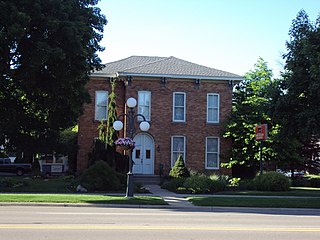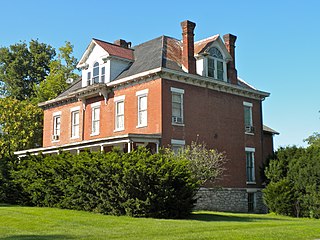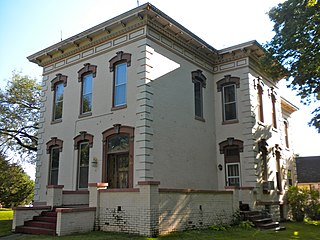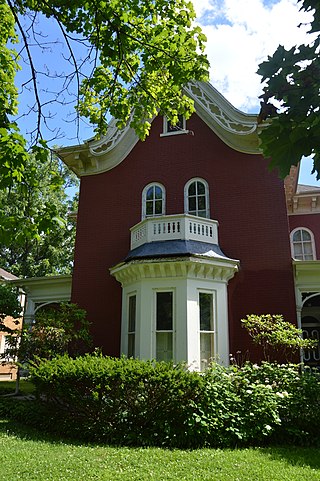
Keokuk is a city in and a county seat of Lee County, Iowa, United States. It is Iowa's southernmost city. The population was 9,900 at the time of the 2020 census. The city is named after the Sauk chief Keokuk, who is thought to be buried in Rand Park. It is in the extreme southeast corner of Iowa, where the Des Moines River meets the Mississippi. It is at the junction of U.S. Routes 61, 136 and 218. Just across the rivers are the towns of Hamilton and Warsaw, Illinois, and Alexandria, Missouri. Keokuk, along with the city of Fort Madison, is a principal city of the Fort Madison-Keokuk micropolitan area, which includes all of Lee County, Iowa, Hancock County, Illinois and Clark County, Missouri.

Samuel Freeman Miller was an American lawyer and physician who served as an associate justice of the U.S. Supreme Court from 1862 until his death in 1890.

George Washington McCrary was a United States representative from Iowa, the 33rd United States Secretary of War and a United States circuit judge of the United States Circuit Courts for the Eighth Circuit.

The Huntington Homestead, also known as the Samuel Huntington Birthplace, is a historic house museum and National Historic Landmark at 36 Huntington Road in Scotland, Connecticut. Built in the early 18th century, it was the birthplace and boyhood home of Samuel Huntington (1731–1796), an American statesman and Founding Father. He served as a delegate to the Continental Congress, where he signed the Declaration of Independence. He also served as Governor of Connecticut and was the first presiding officer of the Congress of the Confederation, the first central government of the United States of America.

George M. Verity is a historic towboat now displayed as a museum ship in Keokuk, Iowa. Built in 1927 as SS Thorpe, she is nationally significant for being one of only three surviving steam-powered towboats in existence in the United States. She was declared a National Historic Landmark in 1989.

Liberty Hall, also known as the Governor William Livingston House, located on Morris Avenue in Union, Union County, New Jersey, United States, is a historic home where many leading influential people lived. It was documented by the Historic American Buildings Survey (HABS) in 1938. The house was added to the National Register of Historic Places as a National Historic Landmark on November 28, 1972, for its significance in politics and government. It is now the Liberty Hall Museum.

The Dr. Samuel Catlin House is a former residence located at 213 East Chicago Boulevard (M-50) in downtown Tecumseh, Michigan, United States. It was listed as a Michigan State Historic Site and added to the National Register of Historic Places on August 13, 1986. It is located across the street from Saint Elizabeth's Church and down the street from the Tecumseh Downtown Historic District.

The Keokuk County Courthouse located in Sigourney, Iowa, United States, was built in 1911. It was individually listed on the National Register of Historic Places in 1981 as a part of the County Courthouses in Iowa Thematic Resource. In 1999 it was included as a contributing property in the Public Square Historic District. The courthouse is the fourth building the county has used for court functions and county administration.

The Davis County Courthouse in Bloomfield, Iowa, United States was built in 1877. It was individually listed on the National Register of Historic Places in 1974. Two years later it was listed as a contributing property in the Bloomfield Square historic district. The courthouse is the second building to house court functions and county administration.

The Hugh W. and Sarah Sample House is a historic building located in Keokuk, Iowa, United States. Hugh Sample became the mayor of Keokuk in 1858 and had the house built the following year. He lived in the residence until his death in 1870. The 2½-story structure was designed in the Italianate style and is considered the finest and most intact example of that style in Keokuk. It follows an irregular plan and features tall narrow windows capped with elaborated crowns, a low pitch gabled roof, and wide bracketed eaves. At one time the house had an ornate cupola. The rooms on the interior have 12-foot (3.7 m) ceilings The house was listed on the National Register of Historic Places in 1995.

The Keokuk Young Women's Christian Association Building is a historic building located in Keokuk, Iowa, United States. It was listed on the National Register of Historic Places in 2004.

The Frank J. Weess House is a historic building located in Keokuk, Iowa, United States. Built from 1880 to 1881, it is considered a fine, although a rather restrained, example of the Second Empire style. The relative restraint of the rest of the house allows the architectural focus of the structure to be its rather elaborate main entrance and front porch. The two-strory brick structure is capped by a mansard roof with bracketed eaves and pedimented dormer windows. The windows on the rest of the house are capped with stone hoods. It was listed on the National Register of Historic Places in 1978.

The Alois and Annie Weber House is a historic building located in Keokuk, Iowa, United States. The significance of the three-story house is its association with the period of industrial growth in the city when it was built and as a fine local example of the Second Empire style. It features an asymmetrical concave mansard roof, decorative brackets, and pedimented dormer windows. The house is noteworthy for its tall narrow windows and high ceilings. Two additions were added to the rear of the house not long after the main house was built. The Queen Anne-style wraparound porch is supported by 14 classical columns. It also features a balustrade and spindlework along the beadboard ceiling. The house was listed on the National Register of Historic Places in 2002.

The John N. and Mary L. (Rankin) Irwin House is a historic building located in Keokuk, Iowa, United States. It was individually listed on the National Register of Historic Places in 1999. In 2002 it was included as a contributing property in The Park Place-Grand Avenue Residential District.

The E. H. Harrison House is a historic building located in Keokuk, Iowa, United States. It was designed in a combination of Federal, Greek Revival, and Second Empire styles by local architect Frederick H. Moore, and built in 1857 by local builder R.P. Gray. It is believed that this is the first house in Iowa to have a Mansard roof, which is its Second Empire influence. The Federal style is found in the building's large windows, the elliptical doorway arch, the bowed two story front bay, and the brickwork. The Greek Revival style is found in the offset doorway. Its interior features a unique open, two-story, self-supporting staircase that is said to be one of seven in existence in the United States. Additions have been built onto the back of the house, but their dates are unknown.

The Gen. Samuel R. Curtis House is a historic building located in Keokuk, Iowa, United States. Samuel R. Curtis was an engineer, congressman and served as mayor of Keokuk in the 1850s. He was the hero of the Battle of Pea Ridge during the American Civil War. Curtis was the first Major General from Iowa during the war. Curtis had this Greek Revival house built about 1849. The significance of the house is its association with Curtis, who died here in 1866. It remained in the Curtis family until 1895 when it was sold. The house was listed on the National Register of Historic Places in 1998.

The Gen. William Worth Belknap House is a historic building located in Keokuk, Iowa, United States. William Worth Belknap moved to Keokuk from upstate New York in 1853 to practice law. He built this Greek Revival style house the following year. It is a two-story brick structure with a single-story wing. The two story section is original, while the single-story section is an addition, built shortly afterward. The house features narrow window openings with simple stone lintels and sills. It is built on a stone foundation covered with concrete and capped with a low-pitched gable roof whose ridge is parallel to the street. The front porch is not original. Belknap resided here with his mother and two sisters.

The Park Place-Grand Avenue Residential District is a nationally recognized historic district located in Keokuk, Iowa, United States. It was listed on the National Register of Historic Places in 2002. At the time of its nomination it consisted of 75 resources, which included 60 contributing buildings, one contributing structure, and 14 non-contributing buildings.

Chief Justice Joseph M. Beck House is a historic building located in Fort Madison, Iowa, United States. It was individually listed on the National Register of Historic Places in 1984. In 2014 it was included as a contributing property in the Park-to-Park Residential Historic District.

The Kirkwood House is a historic building located in Iowa City, Iowa, United States. It was built for the local attorney and businessman Samuel J. Kirkwood who also served as Governor of Iowa, represented Iowa in the United States Senate, and was Secretary of the Interior in the cabinet of President James A. Garfield. The house was built after his second term as governor and remained his home until his death in 1893. His widow remained here until her death in 1923. This was his home during most of his political career and it reflects the "rural and unpretentious style of living" that the Kirkwoods preferred. The house was originally located on a much larger estate, but the rest of it has subsequently been divided into lots and sold. The two-story L-shaped wood-frame structure, which sits further back from the street than other houses on the block, has paired brackets and a roof line cornice as its only ornamentation. The house was listed on the National Register of Historic Places in 1974.























